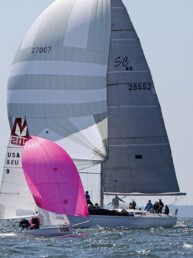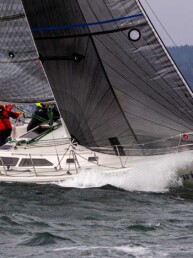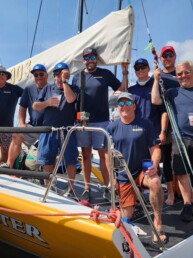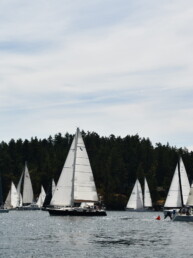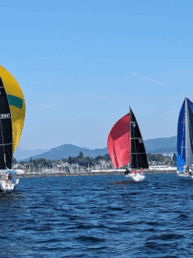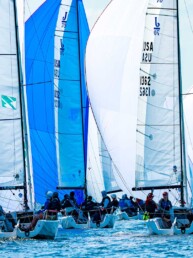While I can’t claim to know the exact origins of the sport of match racing, I’d be willing to guess that it began sometime immediately after construction of the second sailboat was complete. As humans, we seem to have a deep-seated need to know, when given two of anything that moves, which one is faster. Within the world of competitive sailboat racing, there are three different formats in which people race. Fleet racing, which is most common, is multiple boats all racing each other at the same time on the same course, which the race committee sets up based on a variety of conditions. Team racing involves two three-boat teams using tactics to get a winning combination based on how they finish and is raced on the digital N course, an upwind and downwind leg with two reaching portions in between where each mark is rounded to starboard. Match racing is one-on-one—two boats of the same design in a battle of speed and tactics to test which boat and crew is faster. In addition to being the way famed races like the America’s Cup Final are contested, match racing is often the gateway into keelboat sailing for youth sailors in the Northwest.
I caught up with former Western Washington University (WWU) Sailing Team Captain and match racer, Niki Alden, and asked about experiences with Match Racing at the collegiate level. According to Alden, match racing is the only youth sailing event which features the use of keelboats, with most match racing taking place on J/22s or J/24s. Alden said “They’re the perfect intermediate step between the dinghies we’re used to sailing and a larger keelboat. These commonly used designs are big enough that you need a full crew, you fly a spinnaker, and sail it differently; but still are small enough to be more forgiving than a larger boat would be.”

Match racing is somewhat of a rarity in the Northwest due to the limited availability of one design keelboats. When you make the step from dinghy sailing to keelboats, there’s more need to understand that specific boat. In a dinghy, there’s some difference between designs—certain boats point higher than others or and trimming techniques can vary, but it’s still a similar game to achieve good boat speed. What works in a Vanguard 15 will mostly work in an FJ. With more weight and a more complex rig and sailplan, keelboats can be pickier. What works well on a Santa Cruz 27 might not be what a Martin 242 wants in order to go fast. Having experience in really understanding the boat can make youth into better sailors, but finding a fleet has been tricky.
With this scarcity in boats, there hasn’t been a lot of activity for high school sailors getting into match racing, but the college teams have had better luck. Collegiate sailors are soon to face off at the West Vancouver Yacht Club on October 28th and 29th to compete for a chance to go to Match Racing Nationals in Boston, MA, at the beginning of November. While match races begin in a duel for tactics and jostling for position at the start, Alden says that beyond that it’s all speed. “With the Northwest Teams especially, it comes down to knowing how to get that boat moving.” She said that “while those moments at marks in which you’re using tactics to gain are incredibly satisfying, it’s still a race; and races are won by the faster boat.”
One of the primary difficulties in getting a crew of match racers ready can be the trust involved. Alden, whose sailing experience has ranged from FJ sailing to match racing to being an R2AK participant, said, “When you sail with someone in a dinghy, you have to build up an intimate trust that takes time—you need to know that when you throw your full weight toward one side of the boat in a maneuver, your skipper or crew will be there to counter you.” Conversely, she noted that the roles don’t necessarily translate from dinghy to keelboat all that well, and that a larger crew is fundamentally different than the double-handed division of duties most youth sailors are more familiar with. Yet, Alden continued, “On a match racing boat, you don’t have the luxury of growing that connection. There is often an assumption that sailors know what their roles and responsibilities are, and that everyone will preform at the right time. You must give your team your immediate trust.” With far less practice time in keelboats than youth sailors spend in dinghies, match racers are expected to have learned their roles on the bigger boat quickly and often independently outside of an organized practice. Local yacht clubs are helpful when it comes to teaching these sailors the new skills they’ll need for the larger boats.

University of Washington (UW), the University of British Columbia (UBC), and WWU have been the primary competitors in the previous years, with Oregon teams and the University of Victoria making the occasional appearance. Last year, UW narrowly beat out UBC in a sail-off at the end of the event to represent the Northwest at Match Racing Nationals, but every year the teams change. Every team is hopeful coming into this year’s Match Racing Quals, but UW and UBC are still the teams to beat. Though UW is largest and most successful NWICSA team, they still face a fierce competitor with the UBC becasue of the Canadian team’s experience in these particular boats and home-course advantage. Every school competing will send one team made up of three or four sailors to represent them. Since many of the schools are not yet in session, preparation and practice is mostly organized by a few individuals from each team who want to see their teams succeed at this event. This match racing regatta will be held on J/22s but teams are left to their own devices in finding similar boats to practice and train on. Often, Solings or other similar small keelboats make good substitutes.
As the NWICSA teams begin to prepare for the season ahead and the many regattas they’ll compete in, they start the season with a winner-takes-all game of speed and tactics to determine who goes east for the first national championship regatta of the year.
Julia Soes
Julia Soes is the head coach and program director of Sail Orcas and a member of the NWISA board. She races PHRF through the Anacortes and Orcas Island Yacht Clubs and is restoring the fastest Cal 20 the world has ever known, which only rates 300.

